Today’s schedule included no bus tours, no walks along cobblestoned lanes, and no attempts to cram a thousand years of history into a single day. Our sightseeing involved only the views of open sea and sky while the Star Breeze continues traversing the Baltic Sea from Tallinn to Copenhagen, a distance of about six hundred miles.
When we drew the curtains about 7:15 a.m. all we could see was calm dark-gray water and thick light-gray mist. It was still foggy when we went upstairs for breakfast at 8:30. We joined Mark and Lynn at a table on deck and asked the waiter to bring us hot chocolate.

Spa
After breakfast, while Michael was experiencing a “skin energizing” facial, Nancy did her last sinkful of laundry and then, when Iyse arrived to clean our room, went to the library to write until it was time to go to the auditorium for a presentation on traditional Russian art and literature. Elena Ikonorova, one of the cruise’s “enrichment lecturers,” gave us a brief overview of early Russian history to provide background for the artworks and legends she shared.

Vladimir I
Russia’s name is derived from Rus’ (Русь), an ethnic group that established a number of principalities in the geographic area now occupied by western Russia, Belarus, and northern Ukraine during the ninth century. The most successful potentate in the region was Vladimir, who in the tenth century not only consolidated the principalities, but also converted the pagan Rus’ to Christianity. A former pagan himself, Vladimir had embraced Christianity after becoming alarmed by the internecine conflicts the Rus’ pantheon provoked among his subjects. Vladimir sent envoys to neighboring nations to conduct thorough investigations of their religions: Judaism, Islam, Roman Catholicism, and Eastern Orthodoxy. Most impressed by the religious edifices and spiritual practices of the Byzantine church, the envoys recommended Eastern Orthodoxy to the prince. Vladimir thus set about building Orthodox churches throughout his empire, and strengthening political and commercial ties with Constantinople. He is regarded as both a saint and the first czar of Russia.
Vladimir’s effect on the development of Russian art was twofold. First, his encouragement of trade with Constantinople meant that Russian culture became influenced by the styles of the Byzantine Empire. Second, Vladimir’s newly Christianized subjects began creating religious art to decorate their new churches. Following the lead of the Eastern Orthodox in Constantinople, Russian artists emphasized two-dimensional, non-realistic representations of deity to avoid breaking the Second Commandment, and eventually developed a unique style of painted icons that has become characteristic of traditional Russian art.

A 16th-century copy of Our Lady of Kazan
One of Russia’s most venerated icons is Our Lady of Kazan, which is thought to have been brought to Kazan (a city in southwestern Russia) from Constantinople in the thirteenth century. The painting developed an extensive cult following after people began attributing miracles and military victories to it. Over the years, the original icon was stolen, lost, and miraculously rediscovered several times, but was presumably destroyed after its last theft in 1904. However, several copies of Our Lady of Kazan continue to inspire believers across Russia.

Saint Petersburg landmarks are depicted in the blue box at the top. The subject of the large box at the bottom is a troika, a sled or carriage pulled by three horses. This motif was popular for Orthodox Christians who had to hide their faith during the Soviet era because the troika symbolizes the Trinity
Another type of traditional Russian art began to flourish in the eighteenth century, after Peter the Great turned the focus of imperial fashion westward. By this time, tobacco use had become rampant across Europe. Many people took it as snuff rather than smoking, so small, elaborately decorated snuff boxes became popular among the wealthy. (Empress Elizabeth I was addicted, and reportedly would not extend her right hand to visitors because she was embarrassed that it smelled of tobacco.) The most sought-after snuff boxes came from the village of Fedoskino near Moscow. Fedoskino’s artisans constructed their boxes from many layers of heavily lacquered papier-maché and adorned them with miniature paintings.
Subjects for these intricate artworks, which often incorporated shimmery gold leaf or mother-of-pearl elements, included folk tales, religious iconography, landscapes, and portraits. Paint was painstakingly applied with a brush consisting of a single squirrel hair; a wolf’s tooth was used to burnish gold or silver leaf. Contemporary artists in Fedoskino continue to produce exquisite lacquered boxes with miniature paintings for collectors, as well as less-detailed but more affordable pieces for the tourist trade. Elena recommended using a magnifying glass to determine the quality of a miniature painting before making a purchase, but she also encouraged us to go ahead and buy any lacquer work we liked because even the less expensive pieces were likely created by students who are keeping an important Russian artistic tradition alive.
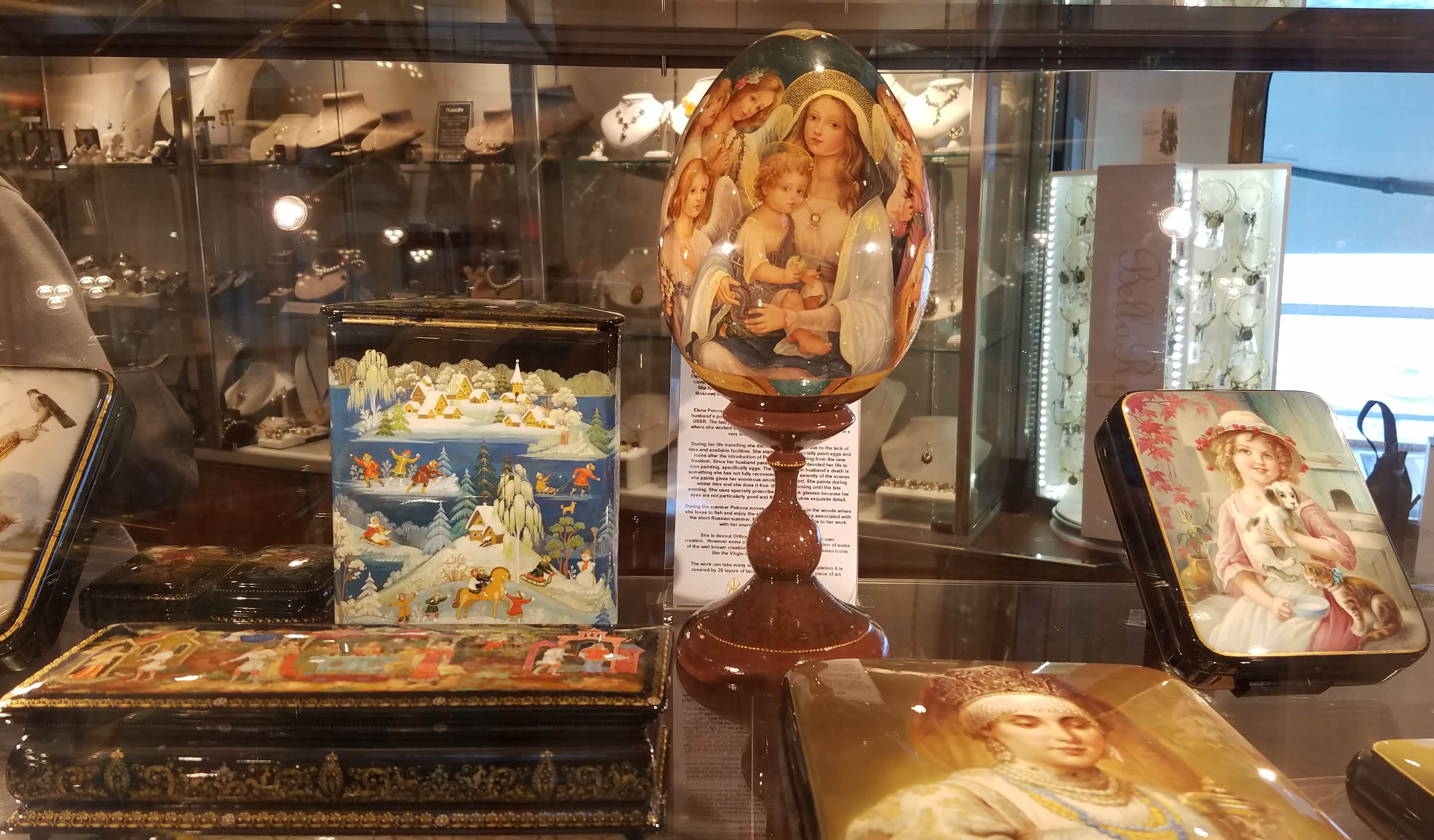
Examples of Russian miniature art on display in the ship’s boutique. The egg was painted by Yelena Petrova, considered one of Russia’s best contemporary miniaturists
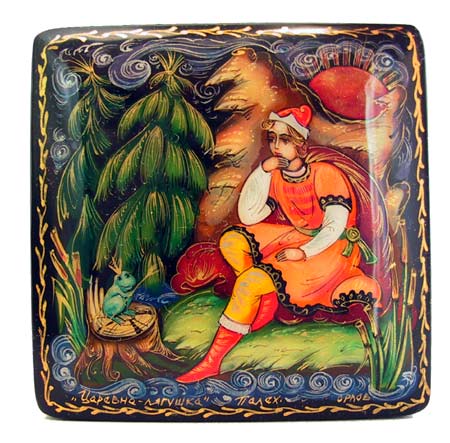
Prince Ivan and the frog appear on this souvenir shop-quality lacquer box
Elena used examples of miniature paintings to illustrate some folk tales as she transitioned to the section on Russian literature and legends. A fairy tale frequently depicted by artists is Russia’s version the Frog Princess, in which a czar tells his three sons to take their bows into a meadow and shoot; wherever they find their arrows, they also will find the princesses who will become their wives. Ivan, the third son, finds his arrow in the mouth of a frog, who eventually reveals that she is really Vasilisa, the wisest, the most skilled, and the most beautiful princess of all. But one evening while Vasilisa is out, Prince Ivan finds a frog skin on the porch and throws it into the fire, mistakenly thinking that if he destroys the skin, he will save his bewitched wife from having to return to her frog form in the morning. Alas, the enchanted princess informs Ivan that he should have been more patient, and that now he will have to seek for her elsewhere. She then turns into a cuckoo bird and flies away. After a long search around the globe, Ivan finally finds Vasilisa in the thrall of a sorcerer, and—with the help of three animals whose lives he spared during his journey—saves her from the evil spell. They return to the palace and live happily ever after.
Such folk tales and historical narratives were the subjects of poet Alexander Pushkin (1799-1837). He is considered the father of modern Russian literature because he was the first major poet to write in Russian instead of French, the language that had been favored by the imperial court since the days of Peter the Great. Much as Shakespeare did for English, Pushkin expanded the vocabulary and idioms of the Russian language and was enormously influential despite the fact that he died relatively young, shot by his brother-in-law in a duel over the poet’s beautiful wife.
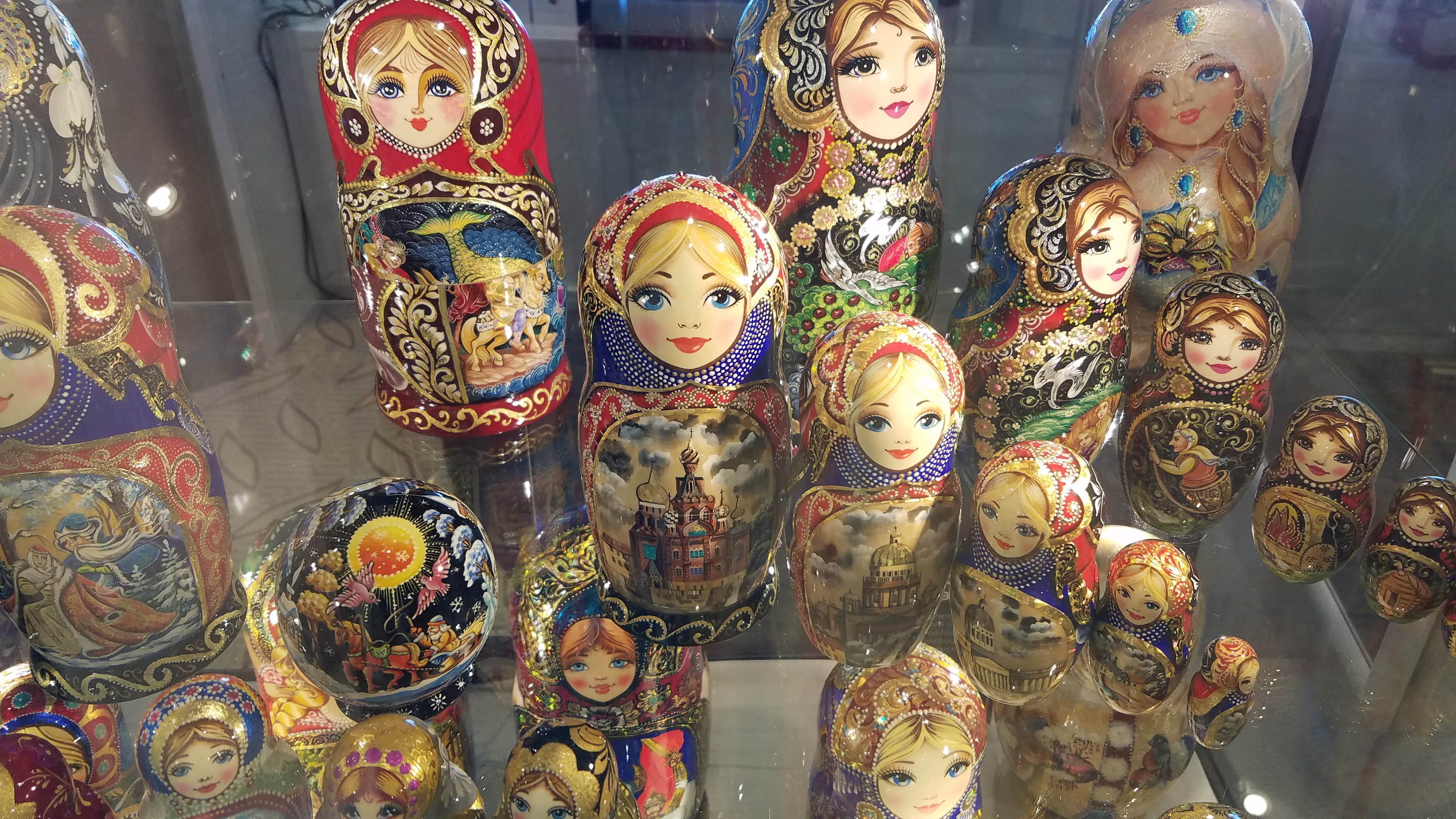
Finely detailed Russian matryoshka dolls
We were surprised to learn that matryoshka dolls, which many of us think of as the most characteristic examples of Russian art, have existed only since 1890, and that their invention can be traced to a specific pair of artisans working at the Abramtsevo artists’ colony outside Moscow. A woodworker named Vasily Zvyozdochkin carved the first set of nesting dolls, which were then painted by designer Sergey Malyutin to resemble a traditionally dressed Russian matron and her children. Such doll sets, originally intended simply as toys, were so popular that they became the template for increasingly elaborate (and expensive) variations. One may now buy matryoshka sets with as many as 72 nested pieces, with themes that range from the traditional to the unconventional. (Nesting soccer teams, anyone?)
By lunchtime the sun had come out, but it was still cool on deck. The most notable items at the Veranda buffet were the desserts: mango soufflé, chocolate crunch pot de crème, and a delectable mixed-berry crumble.
After lunch, while Michael went back to the cabin to write, Nancy attended another educational presentation, entitled “All Things Viking.” It was given by Tony D., another “guest lecturer” whose credentials were never made clear. Although Nancy has not been able to trace her Danish ancestry far enough back to state with certainty that she is descended from Vikings, she nevertheless claims the culture of the notorious seagoing raiders as part of her family heritage, and was eager to learn more about them. Sadly, Tony D.’s presentation was less than impressive, plagued by weak humor and hard-to-read, colorless slides. (Jim later commented that “we could have learned more from reading Wikipedia.”) Here are a few of the more salient points:
- The name Viking may be derived from an Old Norse word for a cove or small fjord, or from a region in southeastern Norway called Viken. During the Vikings’ heyday, about 750-1100 AD, the word vikingr referred simply to an adventurer who went on seafaring expeditions, so it could be applied to honest traders as well as lawless raiders. By the fourteenth century, however, the Norwegian phrase fara i viking had come to mean “go a-raiding” and vikingr had become synonymous with “pirate.”
- Viking society included the jarls (earls), who were the rulers; the karls, middle-class men who had the opportunity to attain higher social standing through raiding; and thræls, the serfs. Most of the thræls were people who had been captured by raiders and brought back as slaves.
- Women had fairly equal social standing with men, although they did not participate in raids. They could own property and run their own businesses, and only females could claim to be prophetesses who spoke for the gods.
- One of the Vikings’ most valuable trading commodities was amber (fossilized pine resin), which washed up as smooth pebbles on the shores of the Baltic and was prized as a gemstone throughout the ancient world.
Tony D. also gave us a not-very-well-organized overview of Norse mythology, in which the universe is divided into nine worlds: Asgard, home of the gods; Midgard, home of men; Alfheim, home of the elves; and six others that he could name but not otherwise describe. Most of what the modern world knows about Norse mythology comes from a collection of texts called the Prose Edda by Snorri Sturluson, a thirteenth-century Icelandic historian who wanted to preserve the style and content of even more ancient sagas and legends; and from the Poetic Edda, a collection of mostly unattributed Old Norse poems that was compiled in Iceland a little later than Snorri’s work. One of the sections in the latter volume is called Hávamál (Sayings of the High One). The “High One” is traditionally identified with Odin, the god of knowledge, wisdom, and poetry, and the creator of the first two humans. A sample:
Cattle die,
kinsmen die,
you yourself die;
One thing now
that never dies:
the fame of a dead man’s deeds.
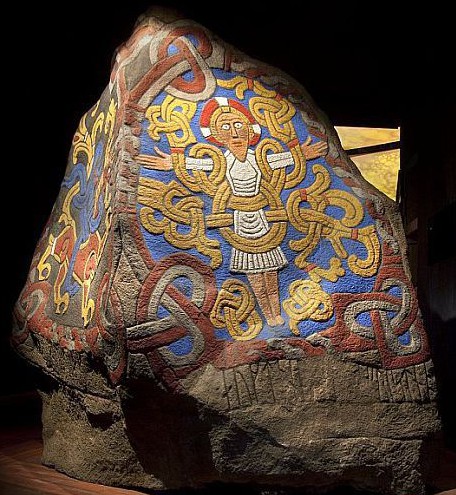
Replica of the Jelling Stone, commissioned about 965 by Harald Bluetooth, the Viking who unified Denmark and converted to Christianity. This side shows Christ hanging from a tree instead of a cross. We saw the original stone (now without paint) when we visited Denmark in 2017
Tony D. also mentioned that there are parts of the Hávamál that resemble biblical accounts of Christ’s crucifixion and resurrection. One example:
I know that I hung on a windy tree
nine long nights,
wounded with a spear, dedicated to Odin,
myself to myself,
on that tree of which no man knows from where its roots run.
No bread did they give me nor a drink from a horn,
downwards I peered.
Tony declined to speculate on why such parallels exist, but it’s an idea we’re still pondering.
Later this afternoon, the members of our Discovery Expeditions and Adventures group gathered in the lounge to hear Jim Gee relate the harrowing tale of his arrest and imprisonment by Egyptian police while he was leading a Discovery XA tour through Luxor in February. We had heard this story in April when we got together with Jim and Carol near their home in Salt Lake City while we were there visiting our kids; however, most of the others in our group had not yet heard more than the headlines, and everyone was eager for details. Jim agreed that it would be best to wait until the whole group assembled before sharing the saga so he wouldn’t have to repeat it ten times. A free afternoon at sea presented the perfect opportunity to schedule a story hour.

Jim in Egypt
If you have been following our blog since our 2015 trip to Jordan and Israel, you will have already met Jim, who (with his wife) runs Discovery XA. In a previous blog, we described him as “the Mormon Indiana Jones,” an amateur archaeologist who turned his passion for antiquities and adventure into a travel business. Egypt is one of the Gees’ regular tour destinations, so Jim has been there countless times over the past thirty years. He not only knows the land and the culture, but he also has cultivated trusted friends and business partnerships with people in the areas he visits. Most of the time, Discovery XA tours run as smoothly as the yachts the Gees engage to take their groups down the Nile, but in February they hit a snag. As Jim was about to lead his group from the Luxor airport onto a Jerusalem-bound plane for the next part of the tour, he was arrested for allegedly attempting to smuggle Egyptian antiquities out of the country.
“It was absurd,” he said. “I did have some antiquities with me, some coins and a few other things that I use in my lectures, but none of them were from Egypt, and I had the papers to prove legal ownership for all but four of the pieces. I usually take all those documents with me to avoid any problems going through customs, but this time I somehow missed putting four of them into my bag. But the Egyptians shouldn’t have cared because the artifacts weren’t even from Egypt; they were from Israel. The customs officials just saw all the Egyptian visas in my passport and assumed I was a smuggler, so they called the police, and the police were so excited to be able to arrest a smuggler that they tipped off the press. By the time they led me away in handcuffs, the place was swarming with reporters and TV cameras.” (Jim, “the American smuggler,” soon became headline news all over Egypt.)
Sorry, but we’re not going to relate the whole story here because it’s not ours to share. Nancy might seriously consider buying the rights to it if she had had any experience writing a screenplay or a graphic novel, but because neither a song parody nor a fifteen-minute roadshow would do it justice, we hope a more capable writer will grab the opportunity to turn Jim’s gripping narrative into a first-class thriller and get it before the public. Audiences would be riveted: Would Jim be able to get the necessary documents from the antiquities dealer in Jerusalem who had sold him the artifacts before he was locked up? Would corrupt officials make him languish in prison for three long months until his scheduled hearing, or would he be able to bribe his way to an earlier court date? Was the mysterious stranger who materialized at Jim’s side in a crowded jail cell and called him by name friend or foe? Would Carol, at home in Salt Lake and trying not to panic, be able to get the U.S. state department involved before Jim vanished into the Egyptian desert? How long could Jim survive in solitary confinement, counting cockroaches to keep himself awake so he wouldn’t slip into the ankle-deep sewage on the floor? Could he manage to escape through that loose window grate? You know the story ends well because Jim and Carol are currently relaxing with us on a luxury cruise ship in the Baltic Sea, but you’ll have to wait for the movie to find out how it all unfolded.
It was difficult to tear ourselves away while Jim was still answering questions about his experience, but Nancy had to get to the spa-salon at the other end of the ship for her haircut appointment, so we left. Nancy needn’t have hurried, because when she arrived the hair stylist was busy removing rollers from the dark-strawberry-tinted hair of another client. It took fifteen minutes for him to spray the thin strands and tease them into a chin-length poof while Nancy sat and watched. She thought the result was not very flattering, but the woman seemed pleased, so who’s to say?
Before we continue with this haircut story, we need to explain that Nancy does not normally patronize spa-salons. For more than twenty years, she allowed Michael to cut her hair (after one brief tutorial by a former roommate), and discontinued that custom only when she decided that it was time for a style that was outside Michael’s limited repertoire. Since then, she has been going to Great Clips, or Supercuts, or whichever walk-in-and-take-your-chances salon offers the most convenience for the lowest price. So you can be sure that Nancy did not make an appointment to get her hair cut at the Star Breeze’s spa-salon this afternoon out of a desire for a “pampering” experience; rather, she made the appointment based on the purely practical consideration that she would need a trim this week, so she might as well get it done during the day she would be stuck aboard the ship. When she booked a slot with the stylist at the beginning of the cruise, she explained that she didn’t want the revitalizing anti-aging collagen shampoo, the deep-conditioning argan-oil hair masque treatment, or the professional blow-out and styling; she just wanted a haircut—like the type the stylist would give a man. (The difference between a women’s haircut offered at the salon and a men’s haircut offered at the same place by the same stylist is perhaps best defined by the fact that the women’s basic cut was priced at $165, and the men’s at $35.)

Salon
So when Nancy took a seat in the salon chair at 5:15 p.m., she told the stylist that all she wanted was a trim: use no. 5 clippers on the lower half of the back, take a half-inch off the top (or about one centimeter, in case the Indian stylist wasn’t familiar with imperial measurements), trim it close around the ears but don’t take too much off the sides (she used her hands to indicate the desired angle from the earlobes up: conical, not cylindrical), and trim the back straight across the bottom, rounding the corners just a bit.
The stylist looked nonplussed. “We don’t have electric clippers,” he said.
Now it was Nancy’s turn to be nonplussed. “You don’t have electric clippers?”
“No,” he replied. “We’re not allowed to use them on the ship for safety reasons.”
“Oooo-kaaay,” said Nancy, drawing out the syllables while she tried to understand why electric clippers might be any less safe to use on a ship than a pair of sharp scissors. “Then I guess you’ll just have to figure out how to produce the same result with some other tool.”
The stylist then pulled a basin up behind her, tilted her head back, and began to shampoo her hair. Even though she had requested no shampoo, Nancy didn’t argue because she realized that if he couldn’t use electric clippers, the stylist was going to need to start this job with totally wet hair. It also was possible that he was stalling for time while he decided exactly how he was going to proceed.
This is how he decided to proceed: First, he combed all of Nancy’s wet hair into a peak at the top of her head, and fastened it there with a long aluminum clip. He then began using a small pair of scissors to trim the hair at the back and around the ears that could not be gathered into the clip. Although the clip-it-out-of-the-way technique is one Nancy is familiar with, she considered it dated because no one had used it to cut her hair for about forty years; but she trusted that the stylist knew what he was doing and watched patiently while he snipped what seemed to be each individual hair across the back of her neck and around her ears.
As he worked, the stylist revealed that he was from New Delhi, and had been employed on various cruise ships for about a year. “Why did you choose cruise ships?” Nancy asked.
“Well, about five years ago my friend and I decided that we wanted to open a hair salon, so we agreed that I would go to styling school and he would get a job to gain some business experience and earn start-up money. By the time I finished my course, though, he had decided that he liked his job and didn’t want to open a salon, so now I’m on my own to earn start-up money. Cruise lines pay better than salons in New Delhi, so here I am.” Nancy was sympathetic to his situation but became skeptical of the training he had received when he tried to convince her that “high humidity in the air actually causes the hair to dry out, and the loss of internal moisture is what makes it become frizzy and unmanageable.” (Uh, no.)
When he began working his way up the sides of her head, still snipping only a few hairs at a time, Nancy could see that the stylist was making the do shorter than she wanted—but she says it was hard to tell how the cut was going to turn out because there was still so much hair clipped to the top of her head. However, as he started unfastening the topknot and dividing out more layers to trim, her trust and patience began to fade. It was now clear that the sides were way too short, but telling the stylist, “This is getting much shorter than I wanted it to be” (as she did) wasn’t going to reattach any of the hair lying on the floor. It also was clear that this process was taking much longer than Nancy had anticipated. It was now a little after 6:00 p.m., so she had been in the barber chair for at least three-quarters of an hour and the job was only half done; usually, she is in and out of the salon in less than twenty minutes.
About 6:15, the stylist glanced at the clock and then asked, “Do you have a dinner reservation tonight?”
“Yes, at 7:00,” Nancy replied. In the mirror she could see the stylist wince. This was not a good sign.
 The stylist removed the remaining hair from the aluminum clip and slowly worked his way across the crown. He was cutting only the half-inch/one centimeter requested, but because he had trimmed so much more from the sides than he was supposed to, the proportions were all off. Nancy looked like she was wearing a stiff paper chef’s toque.
The stylist removed the remaining hair from the aluminum clip and slowly worked his way across the crown. He was cutting only the half-inch/one centimeter requested, but because he had trimmed so much more from the sides than he was supposed to, the proportions were all off. Nancy looked like she was wearing a stiff paper chef’s toque.
When the stylist put down his scissors and began brushing the clippings off her neck and shoulders, Nancy asked, “Does this mean you’re done?”
“Yes,” he replied.
“No, you’re not,” she countered, describing why the stylist needed to take more off the top. She tried to achieve a tone of voice that would register displeasure rather than outrage.
The clipping continued. At 6:30, a different but familiar voice was heard coming from the reception desk in the hall.
“Is my wife still in there?” Michael asked.
“Yes,” Nancy called out.
“How much longer will you be?”
“I don’t know,” called Nancy, trying to achieve a tone that would register resignation rather than distress. The stylist winced again.
During the last quarter-hour of this excruciating experience, the stylist put his scissors away and began squirting something into his palms, explaining that he was going to apply “a finishing product to nourish the hair and give it additional lustre.” Nancy protested; she didn’t want any expensive gunk in her hair, but the man insisted. “You will like it! You will see!”

Imagine this hairstyle in white, with Nancy’s face instead of Nat’s, and you’ll have an idea of what Nancy looked like when the stylist was finished with her
Blow-drying and careful combing followed the product application, and at 6:50 p.m. the ordeal was finally over. Nancy was appalled by the result, but she managed to paste a smile on her face and say thank you to the stylist before she signed the bill ($58, including gratuity) and fled. We regret that we did not get a photo of the stylist’s handiwork because Nancy was in too much of a hurry to get back to our cabin, wash out the lustrous product, and attempt to restyle the little hair left on her head before going upstairs for dinner. Instead, we offer a photo of our son Nat, whose hairstyle is very similar to the one created for Nancy by the young man from New Delhi. It’s a good look for Nat, but not so much for his mother.

Our table in the AmphorA dining room, from left: Budge, Linda, Allison, Mike, Katie, Tony, Ed, Lisa, Jim, Nancy, and Michael’s glasses
When we met our group in the dining room about 7:10, none of our friends was moved to exclaim, “Nancy! Your hair looks marvelous!” Indeed, to Nancy it seemed that everyone was pointedly not remarking on her hair. Morose and dispirited, she felt justified in ordering two entrées (veal saltimbocca and vegetable lasagna—a winning combination) and consuming every bit of both. But she wasn’t the only one to overeat tonight. The fact that this was our last dinner aboard the Star Breeze seemed to embolden everyone at our table to order nearly everything on the menu, and a lot of tastes and samples were shared all around.

Michael and Nancy on deck
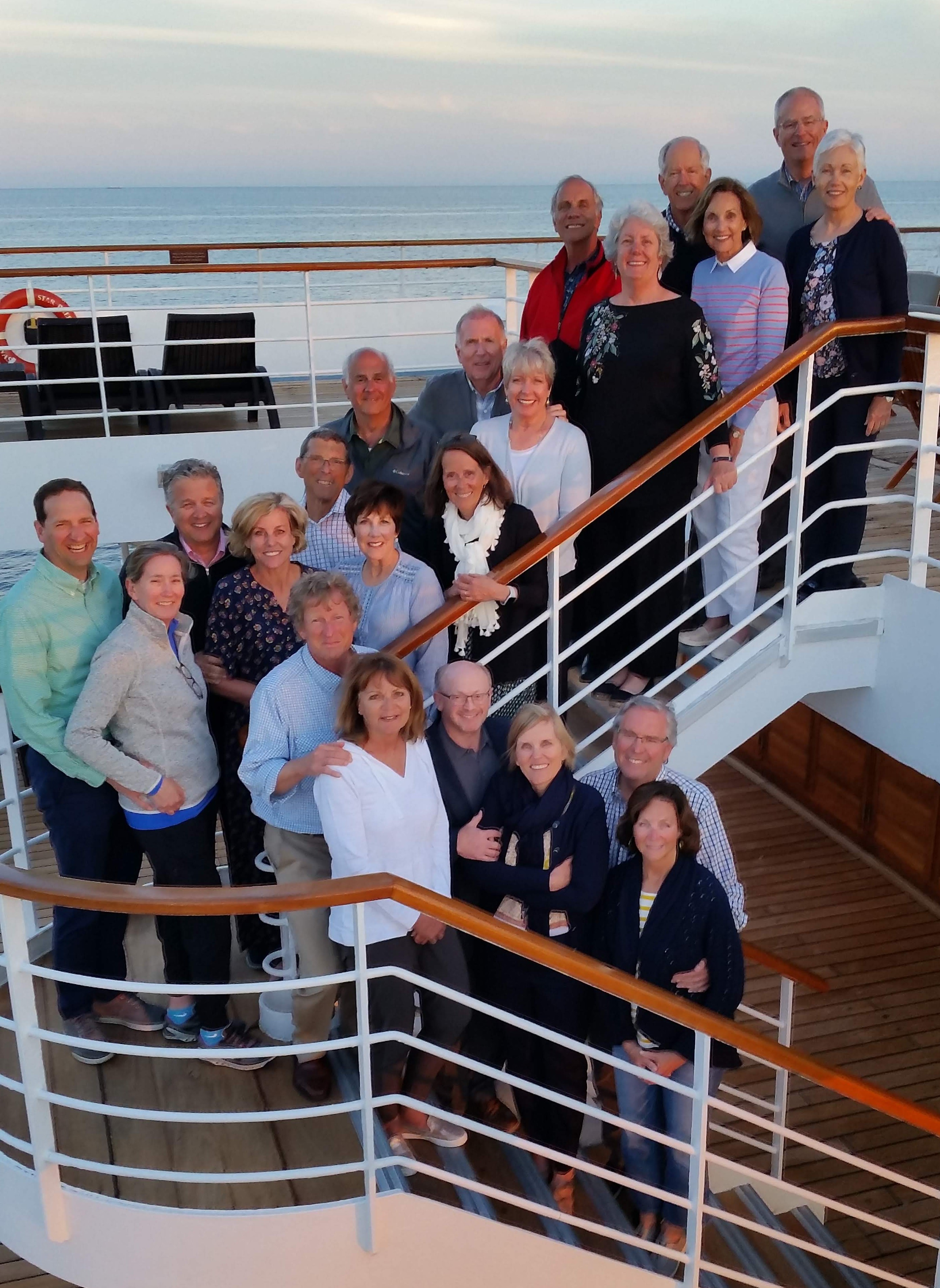
Descending from the top right: Michael and Nancy, Budge and Linda, Mark and Lynn, Eric and Pam, Tony and Katie, Keith and Nan, NJ and Mary-Anne, Ed and Lisa, Jim and Carol, Mike and Allison, Steve and Jan
After dinner, the twenty-two of us went together to the upper deck to enjoy the beautiful sunset and take some “formal” group photos. Noticing through the week that the travel wardrobe of nearly every man in the group includes a checked shirt, Michael proposed that they all wear checks for the group photo. Most complied (Mark, always marching to the beat of his own drum, showed up tonight wearing paisley), but it was so cold on deck that many ended up wearing sweaters over their checked shirts.

Michael, Keith, NJ, Mike, Budge, Tony, Ed, Jim, Mark, Eric, Steve

The Cincinnati women: Pam, Lisa, Nancy, Katie, Mary-Anne, Nan, Linda, Lynn, Allison
Back in 2017, when we had taken our cruise of the Aegean islands—along with several couples also in our present company—our friend Judith had requested that the ladies from Cincinnati bring silk headscarfs for a “glamour photo” of the group, directing them to model 1960s-style as if they were partying on a private yacht with Jackie Onassis or Audrey Hepburn. For this cruise, knowing that we were going to visit some Slavic countries, Judith suggested bringing more rustic headscarfs so the ladies could turn themselves into babushkas for the group photo. Alas, Judith was unable to join us on this cruise (many times during the past week one or another of us has said, “I wish Judith and Richard were here!”) but we resolved to bring the scarfs and take the babushka photo even though our favorite Slavic woman couldn’t be a part of it. We didn’t take the photo in the Czech Republic because our group was not at full complement while we were there, and we didn’t take one in Russia because our guide never allowed us a photo op in any appropriately rustic location, but tonight we decided that we’d better just go ahead and do it. The result owes more to the 1960s glamour model than to the traditional Slav peasant, but perhaps it just shows that our women are multifaceted. Nancy was grateful that the scarf allowed her to keep her super-shorn hair undercover just a little longer.
Back in our cabin, we hurried to reorganize and repack our luggage because we have to put it out in the passage early in the morning for the stewards to pick up. Tomorrow we disembark. It’s been a great cruise, but we’re excited to spend the next few days in Copenhagen.
Leave A Comment